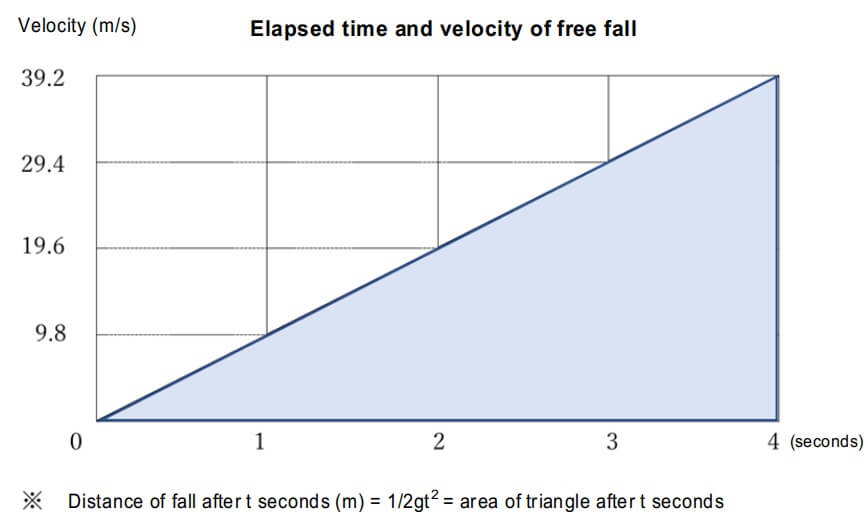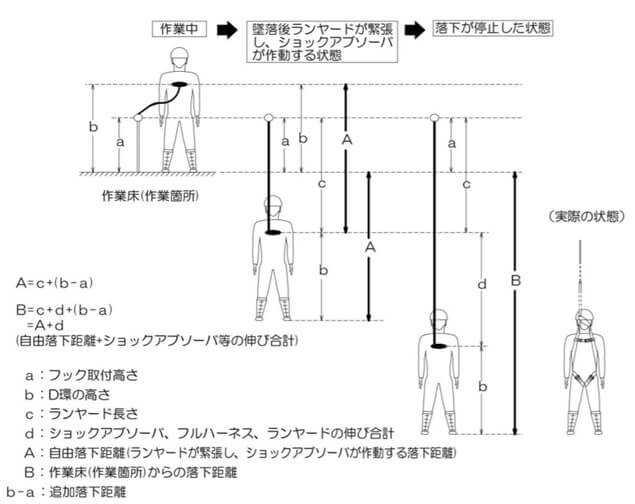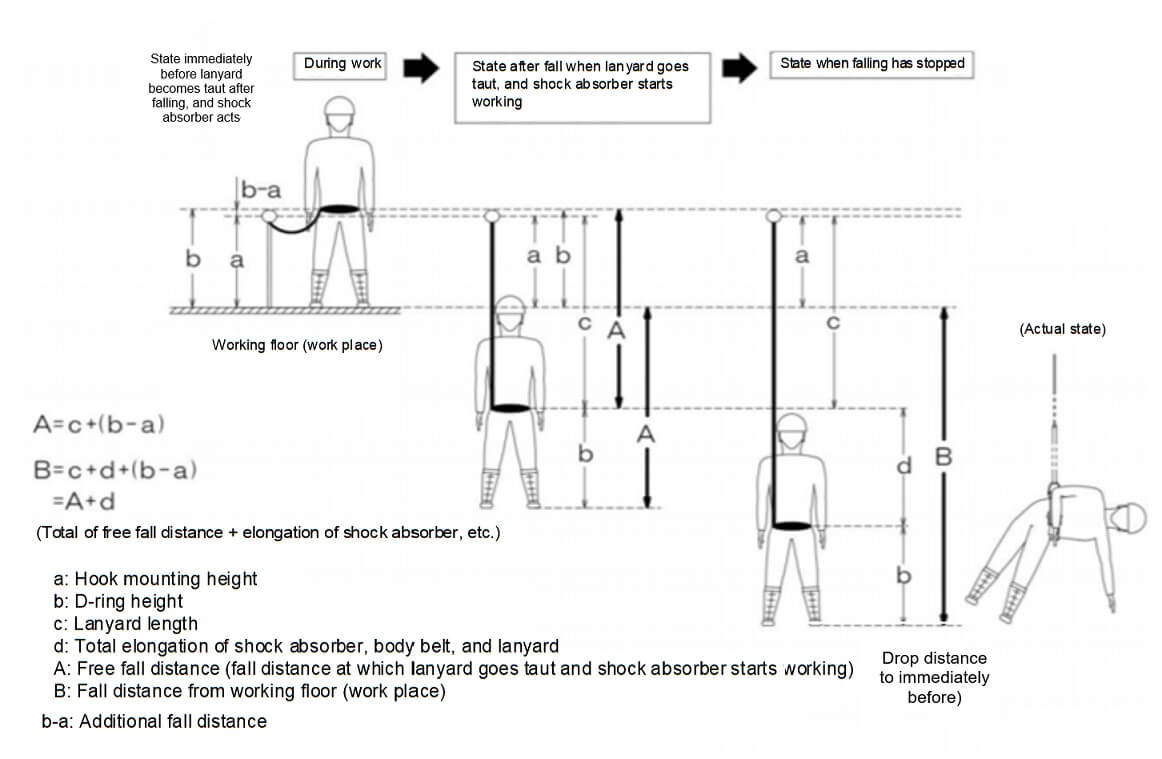[Chapter 1] Section 1 ④
3. Methods of work
Here, “methods of work” describe “how to work at a place with a height of 2 m or more, where it is difficult to provide a working floor, while protecting oneself from a fall/tumbling accident.”
In order to perform various work tasks safely, it is necessary to select protective equipment (fall arrest equipment, etc.) and mounting equipment appropriate for the work, and use them appropriately.
1. Basic approach
As a general rule, fall arrest equipment should be the full harness type.
However, if there is a risk that a person wearing full harness type fall equipment may reach the ground in case of a fall, use of a body belt type is permitted.
2. Selection of appropriate fall arrest equipment
2. Selection of appropriate fall arrest equipment includes selection of the full harness type or body belt type, as well as the type of shock absorber suitable for the height of the mounting equipment for hooks, etc., and the length of the associated lanyard (including winder types with a lock).
The employer must select appropriate fall arrest equipment according to various conditions such as the nature of work, height of the work place, and weight of the worker, and ensure that the worker wears it.
⇔ “Fall arrest equipment with required performance”3.Guideline for the height at which the body belt type can be used
As a guideline for the height at which the body belt type can be used, the value should be equal to or less than the total of the free fall distance and the (maximum) shock absorber elongation, assuming the full harness type is used, plus 1 meter (= elongation of harness, etc.).
Therefore, as a minimum criterion that must be followed in all cases, the full harness type must be used when working at a location exceeding the height (6.75 m) obtained by adding 1 meter to the total of the maximum free fall distance of the shock absorber (4 m) and the maximum elongation of the shock absorber (1.75 m).※ Even if fall arrest equipment is used, effectiveness often cannot be expected if the work place is low.
If work place height is a little over 2m, it must be determined that full harness type fall arrest equipment is not useful.
Fall arrest equipment must be used while considering not just appearances, but whether it will actually protect oneself in case of a fall.
4. Mounting equipment for fall arrest equipment
No matter how high performance the fall arrest equipment that is worn, it is meaningless if there is no place to attach the hook.
Factors like insufficient strength of the mounting equipment itself may also cause an accident. Therefore, precautions like the following should be taken when selecting and using mounting equipment.
- Mounting equipment for fall arrest equipment must have no risk of the lanyard coming loose or off, and be strong enough to fully withstand the impact force at the time of fall arrest.
- Hooks, etc. shall not be attached if the strength of mounting equipment cannot be determined.
- If a hook, etc. must unavoidably be attached to mounting equipment of unknown strength due to the work situation, measures should be taken to reduce the impact load at the time of fall arrest, within the scope of the strength of the mounting equipment, by for example attaching the hook, etc. at a position that is as high as possible.
- If there is a sharp corner in the vicinity of mounting equipment for fall arrest equipment, take measures such as masking so that the lanyard ropes, etc. do not directly touch the sharp corner.
5. Mental attitude for work — Strict practice of pointing and calling
There are many cases where equipment and protective equipment could have been used, but a fall occurred due to failure to attach the hook.
To prevent industrial accidents by utilizing safety equipment and protective equipment, it is essential to ensure safety awareness by each worker.
Practice “pointing and confirming” and consistently/continuously implement “work after confirming safety.
To achieve this, it is important to respect the 3 second interval” (i.e., have the emotional ability to take 3 seconds for confirmation).
[What is free fall?]
Gravity causes things and people to fall at a constant speed regardless of their weight or size (assuming there is no air resistance). (In reality, of course, the speed is much different for hammers and paper.)
The formula V (velocity) = g (gravitational acceleration ≒ 9.8 m/sec2) × t (time) seems difficult, but…
After 0 seconds → 0.0 meters per second
1 second later → 9.8 meters per second
2 seconds later → 19.6 meters per second… 10 seconds later, velocity is 9.8 m/sec2 × 10 sec = 98 meters per second.
In other words, the situation is quite simple: speed increases by 9.8 m/s every second.
Cars, Shinkansen trains, and tool motors are familiar things that accelerate from a stationary state, but they never continue to accelerate beyond a certain speed.
On the other hand, if you fall from a high place, your speed will continue to increase until you violently collide with something.
The higher the place you fall from, the greater the damage.
For example, if you fall from the height of the observation deck of the Tokyo Sky Tree (about 350 m from the ground), the calculated speed when you hit the ground will be about 300 km/h.
This state of continuous acceleration due to gravity (when there is no other resistance) is called “free fall” and fall arrest equipment is available as a countermeasure to prevent collision with the ground.
In the following graph, “free fall” extends from the instant when the fall begins, until just before the shock absorber starts working.

Note) In the case of a fall from a great height, as in skydiving, it is said that the velocity cannot increase beyond a certain level due to air resistance.
[Fall distance, etc. for full harness type]
[Falling distance of body belt type, etc.]
受講者様のご希望に合わせ、以下のタイプの講習会もご用意しています




このページをシェアする
講習会をお探しですか?